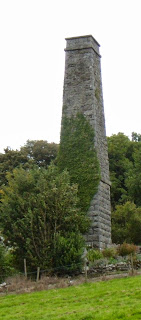One of the very first things that anyone
told me about Leighton Moss was that it used to be arable farmland,
that a steam pump had drained it in the 19th Century, AND that the
only surviving part of that pump and engine-room complex was the chimney at
Crag Foot. Actually, that might be three things, but it’s the chimney part I
want to focus on.
The Crag Foot chimney is a lovely structure. It looms benignly over the Moss, looking every inch the chimney to partner the 12
horse-power steam engine installed by Leighton Hall's Squire Richard Thomas Gillow in 1847.
David Peter’s local history “In and Around
Silverdale” is firmly of the view that this is
the pump-house chimney.
But as I began to research a bit deeper, doubts began to seep in.
Peter Iles the County Council’s archaeology
adviser pointed me to old maps showing that the engine-house (now demolished)
was built down near the Moss – quite a long way below our chimney (which I’ve
circled in green).
(Leighton
Hall Estate Map 1857, kind permission of Richard Reynolds)
Such a long distance between chimney and boiler
was unusual. It was customary and cheaper – Peter explained -- to build them
alongside each other. Although he did concede that it could have been attached
to the engine house by an extended flue – a kind of long, tunnel.
“This was done in some of the steeper
Pennine valleys as it was cheaper than building a taller chimney for a
valley-bottom mill, but I see little justification for the expense on this
site.”
People who have lived immediately around
the chimney told me that they’d always understood it was nothing to do with the pump, and that it had been built to serve the
so-called “Paint Mines” – the iron ore workings on Warton Crag. This could explain why older maps show a chimney on its present site before the engine house was built.
So by this stage in my researches (wake up
at the back) I was pretty much persuaded that this was NOT the chimney that
went with the pump house.
But Richard Gillow Reynolds, present-day owner of
Leighton Hall has always been convinced that it was. He told me so some weeks ago -- and he allowed me to take copies of some interesting documents from the Leighton Hall archives.
It wasn't until I took a much closer look at some of
these that I understood why he felt so confident.
Exhibit A is a sketch attached to an estimate from Thomas Robinson back in 1848. He was the builder engaged to construct both engine house and chimney.
You have to admit that the 1848 sketch
bears more than a passing similarity to our present day chimney. The
accompanying details suggested the stonework was to be “hammer scabbled” -- roughly finished with hammer and chisel. Sure enough, the Crag Foot chimney boasts a "scabbled" finish.
Even more significant is the written estimate's reference to the flue:
"the Chimney flue under
the ground to be got and built by Thomas Robinson"
Might this support the idea that the Chimney was detached from the pumping house and
connected by an underground flue?
And the same document might even explain why some maps show a chimney on the site before the engine house was built. The “old
chimney” --Thomas Robinson writes in his estimate -- was to be “taken down and rebuilt” at a cost of £40 13s 4d.
So it could be that there was an old chimney on the site -- perhaps linked to the iron mines -- which was demolished to make way for the new 1847 chimney connected to the Moss-side steam engine by a length of underground flue.
I'm now almost convinced. If we could just find the line of that flue...





